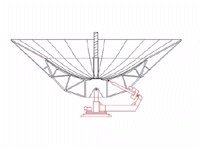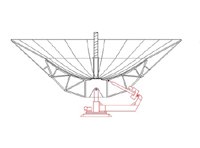

Schematic Drawing of the GEM dish with 408 MHz backfire antenna.
The antenna and its support and control electronics are designed to be easily shipped and operated from minimally prepared sites. The dish is mounted on an alt-azimuth platform, which allows it to be pointed anywhere within 42¡ from zenith.
The lowest frequency systems use a prime-focus arrangement, with a backfire helix antenna feeding to a total power, direct RF-gain receiver. The helix antenna fully illuminates the primary reflector, yielding the finest angular resolution achievable with the existing setup. Higher frequencies utilize a Cassegrain arrangement, with a Dicke-switched direct RF-gain receiver.
Information about the site preparation
The GEM will use locally available, larger antennas (9 meter class primary reflector) for measurements from Brazil and Antarctica. These antenna will allow us to achieve finer resolution, and provide useful comparisons of side lobe pickup and antenna performance with the dedicated GEM antenna
A first set of measurements at 408 and 1470 MHz of the mid-latitude northern sky has been taken from Bishop (CA) during 1994 and at frequencies of 0.408, 1.47, 2.3, and 5.0 GHz from near Villa de Leyve, Colombia in 1995. Analysis of those data is in progress, while the instrument is being readied for observations. We are currently beginning negotiations for observations from excellent sites in the northern and southern hemisphere. The current emphasis is on sites sufficiently good to allow observations at higher frequencies so that GEM can achieve higher angular resolution and a longer lever arm for the frequency dependence. At higher frequencies the emission is much weaker which requires greater sensitivity and longer observation times.
Smoot Group Astrophysics and Cosmology
BCCP homepage